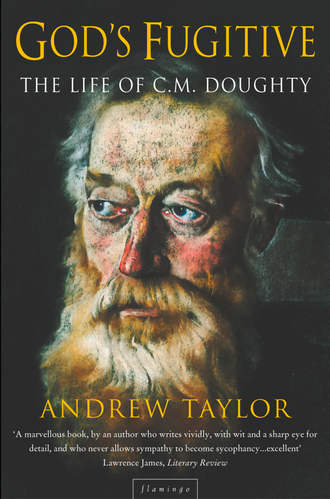
Полная версия
God’s Fugitive
In Barcelona a ship was in port, about to set out for France, and in less than twenty-four hours he was on board. Two nights in Marseilles were spent sleeping under the stars before he found a passage on to Naples, from where he had now decided – his health apparently no longer giving him trouble – to travel on to Greece. ‘The morning of the second day, we cast anchor in the Bay of Naples, a good passage and a fair wind.’
There are four brief lines in his diary noting that he spent some time in the Pension Guidotti, that he climbed Vesuvius again, that he visited the ruins at Herculaneum, and that he spent two or three days on the nearby island of Ischia; but there, abruptly, his own account ends.
With all its infuriating gaps, and with all the obvious limitations of notes scribbled briefly in a traveller’s spare moments, the diary is practically the only clue there is to how the bland, conventional twenty-seven-year-old young man who had left for Holland three years before could develop into the acute observer who would later write the Travels in Arabia Deserta. Although we know from occasional mentions in the diary that he wrote lengthy and descriptive letters home – he refers, for example, to accounts of Madrid and a great bullfight he witnessed there – hardly any of them survive.
That is not an accident: Doughty had throughout his life a passionate sense of his own privacy, and was never a friend to biography. Personal enquiries were answered tersely, if more or less accurately. Almost all his letters home were burned, according to his wife – and after his death she herself carefully destroyed those he had written later to her,1 while Doughty himself replied with horror to an apparently harmless request for a picture of himself for a book on Arabian travel. ‘I have not such a photograph in the world. I may be allowed to say it would be rather contrary to my perhaps now old-fashioned ideas to see a portrait of myself, a private person, in a published book.’2
It is another dimension of his loneliness, the desire for privacy stretching beyond his immediate surroundings. For all its shortcomings, and often despite Doughty himself, the diary offers a rare first-hand, contemporaneous account of three formative years of the life of this determinedly ‘private person’.
It is often little more than a collection of jottings, much like the notebooks he later filled as he wandered through the Arabian desert, with words repeated, sentences unfinished, and judgements half-formed – and yet it still shows the first stirrings of his own writing style, with its incisive, familiar images, its occasional pomposities, and its striving for a proper, judicious scientific detachment.
For the next three and a half years, following his travels is a matter of picking up snippets from letters which were often written years afterwards, references in his later works, grudging notes of his memories in old age. Not until he sets off into the Arabian desert with the Hadj caravan and begins once again to keep a detailed notebook will there be so precise a record of the growth of the writer’s mind.
In the spring and summer of 1873 he based himself in Athens, ‘gypsying’ around the countryside, as he put it – staying at lodging houses or occasionally sleeping under the stars.
A few memories from those days surfaced later as vivid markers in his writings. In The Dawn in Britain, for example, he would describe how the Gauls, in their ill-fated assault on Delphi, were led through the mountains above the Oracle by Thracian guides until they reached the
… parting of two ways, from the cliff-steeps,
Where, of some antique hero, shines white tomb.3
The aching cold of the lonely mountain wanderer is remembered in Doughty’s description of the Gauls encamped on the inhospitable Greek hillside as the snow begins to fall.
Brennus and few lords with him, founden hath
Uncertain shelter, the wild eaves of craigs;
Whereunder, hunger-starved, when fallen this night,
And without fire, they daze, with stiffened joints … 4
He was alone, travelling light, and still without most of his books. The passionate devotion to his ‘studies’ was now firmly behind him; his priority the ruins on the ground rather than the words on the page.
On the other side of the Bosphorus the archaeologist J. T. Wood showed him how those ruins could be brought to life. At the ancient Greek site of Ephesus, Wood was painstakingly revealing the remains of the Temple of Artemis. Doughty was spellbound: the history of Ephesus itself formed an imaginative bridge between his own various interests. The temple linked it with the sites of ancient Greece he had just been visiting; there was the Christian foundation of St Paul to involve his sense of religious history, and the story of the destruction of the city by the Goths in the third century to excite his interest as a student of the tribes of northern Europe.
Stone by stone, the temple was emerging from the ground. Wood, standing with his wife in the middle of the excavation, and sketching out on a sheet of The Times possible designs and elevations of the way it might once have looked, readily rebuilt it in his imagination for his fascinated guest.
Doughty’s earlier experiences at Hoxne had hardly prepared him for anything like this. The diggings had been going on for ten years already, and he had never seen work on such a scale before. It was a foretaste of the imposing ruins he would see over the next few months and years.
Having reached Ephesus, on the Asian side of the Aegean, his taste for archaeology fired by Wood, he must have thought it would be as easy to go on towards the Holy Land as to go back towards Europe. After all, England held few attractions for a thirty-one-year-old scholar of uncertain expectations – no home, no close family ties, no career, and only the uninviting prospect of a slightly shabby and threadbare life of genteel poverty.
He described himself later as ‘interested in all that pertains to Biblical research’,5 and it would have been very like Doughty to want to be able to place the books of the Old and New Testaments in a physical context for himself. But he was still not planning any extensive journeys among the Arabs: his taste of Islamic culture in North Africa and Spain remained just another element in the general experience of his travelling.
On he went, towards the Promised Land. Years later, he sketched out an itinerary for his wife – Latakia, Tripoli, Beirut, Sidon, Tyre and Acre, the route of scores of tramp steamers carrying freight and passengers from port to port. At Sidon and Tyre he collected some Roman mosaic tiles, later presented to the Ashmolean Museum at Oxford – but it seems likely that Doughty abandoned his ‘gypsying’ at least for a while to travel by sea. From Acre, though, he told his wife that he set out on foot again, on the slow journey to Jerusalem. Now he was travelling along roads he had read about and been told about since his infancy, through a landscape where the place-names rang with the sounds and rhythms of the Authorized Version.
But the only brief glimpses of Doughty coming face to face with the realities of the traditions he had drunk in so avidly come through occasional references written down years later in Travels in Arabia Deserta. As he set out with the Hadj the following year on his way south to Medain Salih, for instance, his attention was drawn to the devout Persian pilgrims just starting their journey.
These men, often red-bearded and red dye-beards, of a gentle behaviour, much resemble, in another religion, the Muscovite Easter pilgrims to Jerusalem. And these likewise lay up devoutly of their slender thrift for many years before, that they may once weary their lives in this great religious voyage … 6
It is easy to picture the tall, retiring Doughty, red-bearded himself, watching intently from a distance as the Russian Christians arrived in the narrow streets of Jerusalem, amazed at their fanaticism and yet admiring their devoutness. Their great voyage was over; his was yet to begin.
Doughty’s travels during the next two and a half years took him through Gaza to Egypt, from where he struck out into the Sinai peninsula on a three-month expedition, before making his way back north towards Damascus.
With Bedouin guides, I wandered on through most of that vast mountainous labyrinthine solitude of rainless valleys, with their sand-wind burnished rocks and stones, and in some of them, often strangely-scribbled Nabataean cliff inscriptions – the names, the saws, the salutations of ancient wayfarers.7
In Europe he had been a man alone, travelling through a landscape and a cultural environment that were often well-known, but which did not engage his imagination. Here, paradoxically, the strangeness and unfamiliarity of the desert brought him a new sense of fellowship. The man who found human society so hard to deal with felt himself one with a small and select band of travellers, their ‘names, saws, and salutations’ passed down to him over the centuries.
It was a crucial time, bringing together his studies of geology, of language, and of the people of the region. The formation of the landscape, the development of words, the derivation of names and the roots of a popular culture could all be seen more starkly and clearly in this unchanging world than had been the case in Europe.
While Doughty notes occasional Roman remains in Jerash and Amman, and finds echoes of Greek tradition in the Nabataean carvings,8 he is moving all the time deeper into an unknown world, a culture whose roots were neither Greek nor Roman. But there was one ever-present link. The Bible, which he carried with him both in his pack and in his head, provided him with a constant reference point, a textbook of how the region had been centuries before. There is clear delight in the Travels whenever he manages to relate the ruins or the landscapes he found to the stories of the Old Testament, like the carved stone water-tanks he saw around Hebron and the Dead Sea – where King Uzziah was said to have ‘built towers in the desert and digged many wells’ for his cattle.9
Sometimes, the bland censoriousness of the young man who had left Belgium shows through: he can show the petulance of any traveller disappointed by what he sees, with a bad-tempered and contemptuous belief that the world and the people have degenerated, that the buildings he finds are monuments to a long-past golden age beyond the reach of ‘these squalid Arabs’. There was often a wry contrast between the lush poetic beauty of the ancient verses and the everyday reality of the present. In Hesban, for instance, he came upon the ruins of the biblical city of Heshbon – the same place that the poet of the Song of Solomon had seen before him. There … is a torrent-bed and pits, no more those fish-pools as the eyes of love, cisterns of the doves of Heshbon, but cattle-ponds of noisome standing water.’10
The poetry, evidently, had seeped away over the centuries. Now, his imagination was fired by the links between past and present – the continuity imposed by the lives of the people on ruins which seemed to speak only of mortality.
The thread was often personal, like the carvings of Sinai which seemed to be addressed to him as one of a small band of desert travellers. Or it could be linguistic – he wondered, for instance, whether the ruins of Lejun, ‘a four-square limestone-built walled town’ in the desert, could be all that was left of an outlying Roman military station, with its name a corruption of the Latin legio. But there is, crucially, an introduction for Doughty to the unchanging nature of nomad life, a sense that while buildings may crumble, human life goes on: at the same broken-down walls and arches of Lejun, he saw a small Arab encampment.
Beduin booths were pitched in the waste outside the walls; the sun was setting and the camels wandered in of themselves over the desert, the housewives of the tents milked their small cattle. By the ruins of a city of stone they received me, in the eternity of the poor nomad tents, with a kind hospitality.11
It is the tents, not the stone walls, that achieve immortality. One of the first things he notices later, when he reaches the ruins of Medain Salih, is the way that the stones lining the well, still used by the travelling Arabs, are scored by the ropes of generations of beduin, hauling up their water. ‘Who’, he asks, ‘may look upon the like without emotion?’
His search for ancient remains was almost obsessive: the Arabs, he said impatiently, were ‘too supine and rude’ to work out how many ruins there were, but in two days’ riding near the town of Kerak he claimed to have visited about forty separate sites. There were disappointments, of course – sites with carvings and inscriptions that he was unable to find, and others that he decided were not worth the visit – but it was among these ruins that he began to form his views of the Semitic culture and the Semitic people.
These travels also helped, incidentally, in forming his estimate of the value of oral evidence: some stories, like some sites, were worth more than others. At the Roman site of Jerash, he was told, there was the grave of the Islamic prophet Hud – who, he added tartly, ‘lies buried in more places in Arabia’. There was the now-sanctified Alexander the Great, whose body was to be found – ‘if you will believe them’ – under a heap of stones at Rabbath Moab; and at Kerak he was shown the sepulchre of Noah – ‘who is, notwithstanding buried, at great length, in other places’. Later, as he travelled through Arabia, he was to hear stories of the miracles he was supposed to have performed himself, lifting huge boulders with a single touch of his fingers – ‘and yet at such times I was sleeping, encamped with the Aarab,* nearly half a mile distant …’12
But it was not only old wives’ tales about famous graves that aroused Doughty’s scepticism. Travelling around the Holy Land was further undermining the foundations of his belief, which had already been so dangerously chipped away by his scientific studies. Everywhere, he saw the impossibility of accepting much that he had read for years in his Bible.
He liked to use the Bible as a historical guide, and he was not afraid to test its assertions against science and logic. His own slow progress across the desert set him thinking about the exodus of the Jews from Egypt – two and a half million people, six million camels and seven million cattle. When he asked whether even the whole of Sinai, the worst pasture in the world, could have kept them alive, it was no more than the sort of question that scientists had already started asking of the Scriptures – but Doughty’s presence there in the desert lent it a new point and strength. On all sides, his religion was under attack.
He saw, too, the frequent gulf between faith and human kindness, and the way that religious fanaticism could actually shrivel up ordinary, decent humanity. The man whose faith had already been shaken by his studies in libraries and laboratories was now seeing it put under further strain by his own experience in the world.
There was little enough emotional support from the Greek Christians who lived among the Arabs – a ‘lickdish peasant priest’ at Kerak and his congregation, for instance, among whom Doughty found no evidence of sanctity or a Christian life. ‘To the stronger Muslims I would sooner resort, who are of frank mind and, more than the other, fortified with the Arabian virtues,’ he commented.13 It was a telling condemnation from a man who was later to be criticized for his unbending attitude towards the faith of his Muslim hosts.
But he had no illusions about the generosity and humanity of the devout Muslims either. Later, when he set off with the Hadj, he would see a dying beggar by the wayside, ignored by the passing pilgrims, but then picked up and helped by one of Doughty’s own servants, ‘a valiant outlaw, no holy-tongue man, but of human deeds’.14 In another bitter moment, he exploded: ‘Religion is a promise of good things to come, to poor folk, and many among them are half-destitute persons. Oh what contempt in religions of the human reason!’15
In both comments he was speaking specifically about Islam, ‘the dreadful-faced harpy of their religion’ – but his choice of words is significant. It was not only Islam, but religion as a whole, that seemed to have failed.
His quarrel, in fact, was with neither Islam nor Christianity, but with the rigidity of both; his respect, then as always, for the relation between the individual and God. The Hadj might be, as he suggested, a cruel deception practised on the guileless pilgrims; perhaps there was nothing but contempt due to the more ostentatiously devout among them and their ‘loathsome washings’. But their patience, their determination, their religious stamina, could only impress him. ‘There are very few who faint: the Semitic nature, weak and quick metal, is also of a wonderful temper and longsuffering in God,’ he wrote.16
For the first time in his travels his interests started to encompass the welfare and the day-to-day life of the people among whom he was living. Where before he showed no interest in the politics of the countries through which he was travelling, he now noticed indignantly the debilitating effect of the incompetence, inefficiency and corruption of the tottering Ottoman empire. ‘The name of the Sultan’s government is a band of robbers,’ he wrote.17
At least some of the barren land, he suggested, could be reclaimed for crops, much as the Arabs ploughed the soil around their villages to eke out a scanty living. Towns and villages, deserted for centuries, might easily be reoccupied: in the ruined city of Umm Jemal he walked through narrow streets and courts choked with giant weeds, his sandals soft on the basalt slabs underfoot. The stone-built houses still had their roofs and walls intact; only the people were missing. ‘The “old desolate places” are not heaps and ruins, but carcases which might return to be inhabited under a better government: perhaps thus outlying, they were forsaken in the Mohammedan decay of Syria, for the fear of the Beduins,’ he wrote, with a touching faith in the power of strong government.18 It was, he said, only the lack of such strength and determination that stood in the way: the impoverished Ottoman empire was unable even to pay the wages of its soldiers, or to repair the roads and bridges which were falling into ruin.
The European powers, of course, were only too anxious to make what profit they could from the Ottoman empire. For several decades would-be entrepreneurs had cast a greedy eye on the underdeveloped Ottoman wastes: the historian Sir Edward Creasy was only one voice among many when he predicted, ‘With improved internal government, European capital will be poured into Turkey, and will enrich the land where it is employed … the busy hum of European industry will increase and find innumerable echoes …’19 That was the optimistic prediction of the 1850s; what had happened in fact was that heavy borrowing and spending in European markets had bankrupted the empire by the mid 1870s.
But while Doughty was a fervent patriot and a dedicated nationalist, he was never an imperialist. He had little interest in the growth of empire for its own sake, and none of the exaggerated estimation of many empire-builders of the abilities of his countrymen. He for one saw little prospect of wealth for either side in talk of western settlers taking over the land. There was, he said, no reason to suppose that the first generation of European settlers would be any more successful than the Arabs in tilling the desert, while succeeding generations would be moulded by the environment in which they lived. ‘Were not the sending of such colonists to Syria, as the giving of poor men beds to lie on, in which others had died of the pestilence?’20
As word of his wandering spread, Doughty was becoming something of a legend among the Arabs: a European Christian traveller, with an unaccountable interest in unregarded ruins and old carvings, and an insatiable appetite for anything fellow-travellers, villagers or wanderers on the road could tell him about their life. The Arabs with whom he travelled told him that the region had hardly been seen by Europeans, despite its moderate climate and plentiful water; if he encountered occasional suspicion and hostility, he appears to have been treated much of the time with a sort of amused acceptance. Mohammed Aly, later to be his unpredictable host at Medain Salih, was one of a number of people whom he met during this period; so too was Mohammed Said, the Kurdish pasha who was in charge of the Hadj caravan which Doughty eventually joined. The latter, Doughty boasted, had ‘known me a traveller in the lands beyond Jordan, and took me for a well-affected man that did nothing covertly’.21 It was to prove a useful, as well as a creditable, reputation.
In Sinai he found a naked country, its rocky mountains camouflaged by neither vegetation nor soil, and the memory stayed with him through his life, to surface in his last years, in the poem Mansoul.
An austere soil is that …
Whose bald, sun-bleached, gaunt untrod mountain rocks
Stand, like some bone-work of a former earth … 22
The memory is geological in its scale, and there is also a sense of a lost, disappeared world – a sense that is reinforced by the few mysterious traces of human life.
Doughty was on a lonely track south of Suez, heading for an old Greek Christian monastery, when he saw what seemed to be a strange stone cottage, its doorway blocked up with rocks and brushwood. An ageing Arab camel-driver barred his way. ‘I would have removed some sticks to look in, but the old Beduin cameleer made signs with the hand … that men lay therein, stark upon their backs with closed eyes, and with the other, he stopped his nostrils …’23
His curiosity had taken him to the doorway of a bedu burial chamber, one of dozens of round, stone-built huts he found huddled together in little groups in the most barren and secluded parts of the region.
Later he described them as ‘mosquito huts’, supposedly built by the former inhabitants of Sinai for protection through the night from swarms of insects. In reality, neither he nor the Arabs who were travelling with him had any idea of their original purpose, their age, or who had built them, but they caught his imagination as unchanged remnants of a distant past. ‘They could easily have been in existence for just a few years, or even a few centuries. I have a conjecture they could have been the huts of immigrants who had spread out across the entire Egyptian stretches of desert since the time of Antonius …’24 As the bones of the landscape were naked to the eye, so too were the rare marks of man – not buried or ruined, not needing reconstruction like the buildings at Ephesus, but simply left behind on a barren landscape, among the
Inhuman silent solitude of sharp dust;
Wind-burnished stones and rocks.25
And the feeling that nothing changed was reflected, too, in the few people who scratched a meagre living in Sinai. They lived along the Red Sea coast as they had done for centuries. Neither the lush imaginations of the Victorian orientalists nor even the poverty he had seen himself in North Africa can have prepared Doughty for this glimpse of timeless Arab hardship. ‘These people had neither clothing nor a roof for protection: in the main they live miserably from the food which they can fish or gather from along the shore. The Arabs rightly put down their dark skin colour to their perpetual hunger and nakedness.’26
Even in the grim hierarchy of suffering that Arab life represented. these nomadic fishermen must have been near the bottom. Later, as he travelled with the bedu tribesmen, Doughty would focus upon the life and the culture that could lie behind hardship; here, no doubt still feeling himself to be the detached European traveller studying a strange and savage people, he saw no further than their grinding poverty.
It was here in Sinai that his search for the roots of humanity really began. The landscape, the mysterious buildings, even the people themselves, showed little sign of having been changed by the centuries: here for the first time he could see the perspective that his travels would offer of the origins of human life. The search for the distant history of Arabia, he believed, would help to supply an answer to the question which Isaiah had posed in the Bible, and which rang in his mind: ‘What was that old human kindred which inhabited the land so long before the Semitic race? Does not the word of Isaiah come to our hearts concerning them? … “What was the rock whence ye were hewn, and the hole of the pit whence ye were digged?’”27









